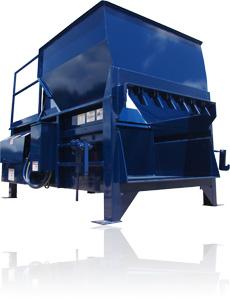Inexpensive Baler Rental for Organizations Handling Huge Volumes
Inexpensive Baler Rental for Organizations Handling Huge Volumes
Blog Article
Exploring the Crucial Role of Waste Tools in Modern Recycling Processes and Sustainable Garbage Disposal Practices
The crucial duty of waste equipment in modern-day reusing processes highlights its importance in achieving lasting garbage disposal practices. Advanced systems, such as automated sorting innovations and compactors, not just improve efficiency but also play a critical duty in minimizing contamination prices and boosting material recuperation. As the need for more sustainable options grows, it is necessary to analyze how these modern technologies adapt to advancing challenges within waste monitoring. What innovative advancements are on the horizon that could even more change these processes?
Relevance of Waste Equipment
Why is waste tools critical in the reusing process? The efficiency of recycling procedures hinges dramatically on the availability and performance of waste equipment. This classification of equipment and tools is crucial for the effective collection, processing, and sorting of recyclable materials. By promoting the splitting up of materials, waste devices reduces contamination, which is paramount in ensuring high-quality recyclables that can be reintroduced right into producing cycles.
Additionally, waste tools boosts operational efficiency and security within reusing facilities. Advanced equipment, such as shredders and balers, allows for the fast processing of huge volumes of waste, minimizing labor prices and processing time. Additionally, using specific equipment decreases the danger of injury amongst employees by automating dangerous jobs.
Moreover, the ecological influence of recycling is intensified by efficient waste equipment. By maximizing the reusing procedure, facilities can significantly decrease the quantity of waste sent out to land fills, thus contributing to sustainability initiatives. To conclude, waste devices is not simply an ancillary element of recycling; it is an essential aspect that drives performance, safety and security, and environmental stewardship in modern waste management methods.
Sorts Of Waste Equipment
The efficiency of recycling procedures is carefully connected to the particular sorts of waste devices utilized while doing so. baler rental. Different categories of equipment are important to the collection, arranging, processing, and transportation of recyclable products
Firstly, collection equipment, such as waste collection vehicles and bins, is crucial for collecting recyclables from various resources, consisting of residential, business, and commercial locations. As soon as accumulated, arranging equipment, including conveyor belts, shredders, and magnetic separators, plays a crucial function in differentiating various product types, ensuring that pollutants are gotten rid of prior to processing.
Processing tools, such as balers and compactors, even more prepares products for recycling by pressing and packaging them right into convenient sizes. This not just optimizes area but also improves transport efficiency. In addition, specialized machinery like granulators and extruders is used for transforming materials into recyclable kinds, especially in plastic recycling.

Function in Recycling Procedures
In recycling procedures, the duty of waste tools is pivotal in ensuring performance and efficiency at every phase. This devices includes a series of machinery designed to deal with, procedure, and sort products that are to be reused. The initial phase entails collection and transport, where compactors and balers play a critical function in enhancing the quantity of products for transit, thus minimizing functional prices.
When at the recycling center, shredders and crushers enter play, damaging down products right into manageable sizes ideal for view website more processing. These machines add to improving the surface location of recyclables, facilitating a lot more reliable product recovery. Sorting systems, furnished with advanced technologies such as conveyor belts and optical sensors, make certain that products are precisely divided by type, consequently making best use of the quality of the recycled final product.
Additionally, specialized devices for handling details products-- such as glass, plastics, and steels-- ensures that each kind is dealt with in the most efficient way. In general, the combination of advanced waste tools right into the reusing process not only enhances operations however also dramatically adds to the total recuperation rates of important materials, underscoring its essential function in contemporary reusing efforts.
Influence On Lasting Practices
With the reliable procedure of waste equipment, reusing procedures considerably boost lasting practices across numerous industries. By enhancing sorting and handling functions, progressed waste devices lessens contamination in recyclable products, consequently improving the top quality of recycled output.

Moreover, the combination of wise innovations in waste monitoring systems enables real-time data tracking and analysis, leading to even more educated decision-making and functional efficiencies. As sectors progressively prioritize sustainability, the function of waste devices becomes vital fit methods that line up with environmental stewardship and governing compliance. Inevitably, the harmony in between waste equipment and reusing processes plays an essential duty ahead of time more comprehensive sustainability objectives throughout communities and markets alike.
Future Patterns in Waste Management
Arising trends in waste administration are poised to reshape the landscape of reusing and source recuperation considerably. One of the most crucial changes is the integration of sophisticated innovations such as expert system, artificial intelligence, and the Internet of Points (IoT) These innovations facilitate enhanced arranging processes, improving the performance and precision of recycling procedures. Smart waste bins outfitted with sensing units can keep an eye on waste levels in real-time, optimizing collection routes and reducing functional expenses.
Furthermore, the circular economic climate version is getting grip, promoting the concept of reusing materials rather than taking care of them. This trend motivates services to create products with end-of-life factors to consider in mind, driving the requirement for cutting-edge waste monitoring solutions.
Additionally, public understanding and engagement in sustainability techniques get on the surge, leading to raised involvement in reusing programs. Federal government policies are also evolving, with stricter policies on waste disposal and motivations for sustainable techniques.
As these fads assemble, they create an extra reliable, sustainable waste management system that not only reduces environmental effect but likewise fosters economic growth with resource recovery and advancement in waste devices. The article source future of waste monitoring looks appealing, driven by modern technology and a dedication to sustainability.
Final Thought
To conclude, waste tools plays a crucial duty in enhancing the effectiveness and efficiency of modern-day recycling processes. By lessening contamination and taking full advantage of material healing, progressed machinery sustains lasting waste disposal techniques and promotes a round economic situation. The unification of wise technologies further enhances these initiatives, making certain responsible ecological stewardship. As waste administration remains to evolve, the value Full Report of cutting-edge waste tools will certainly continue to be critical in achieving sustainability objectives and addressing the obstacles of source deficiency.
Report this page